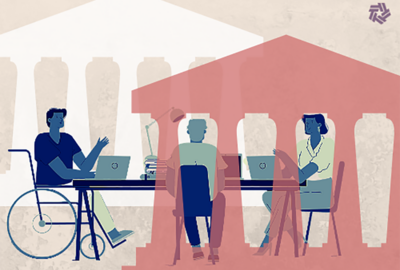Hubbard Radio Washington DC, LLC. All rights reserved. This website is not intended for users located within the European Economic Area.
Anything can have DEIA if agencies look hard enough
If agencies only measure diversity, equity, inclusion and accessibility through hiring numbers they risk overlooking other, equally important gaps in their syst...
Time for some word association: If I say “diversity, equity and inclusion,” you say, “race?” Maybe “women,” maybe “LGBTQ?” You think how many women are in my office, how many Black and brown people are in my office, how many Asian people, or openly queer people? Now if I add “accessibility” to that list you say, “disabilities” or can people in wheelchairs get around my office easily?
You’re not wrong to interpret DEIA this way. Faces, bodies, last names, accents and proportionality all need to be included in federal agencies’ efforts to comply with the president’s Executive Order 14035, but they are not the full story. If people in your workplace, friend group, family, or maybe you, are still struggling to understand these principles, that’s not surprising. Our societal conceptualization of DEIA has changed dramatically over a short period of human history. Since 2004, DEIA’s share of Google searches has been almost nonexistent when compared to diversity and equity, yet the largest source of interest in the term so far has been in Washington, D.C.
Traditionally we envisioned these terms as confined to human bodies, and where those bodies exist. But if we only measure DEIA this way we risk overlooking other, equally important gaps in our systems and policies. These gaps may not have a human face, but they can ultimately still hurt people. Several examples from Federal News Network’s recent coverage illustrate the multiple angles from which agencies need to consider DEIA if they want to make lasting progress.
Widening the net of opportunity for businesses
The Biden administration wants $100 billion more contracting dollars to go to small and disadvantaged businesses over the next five years. As Lesley Field, acting director of the Office of Federal Procurement Policy told the Federal Drive with Tom Temin on Tuesday, the federal government spent $145 billion in fiscal 2020 with small businesses, or about 26% of eligible dollars. But only about 10%, or $59 billion, went to small disadvantaged businesses.
This starts with improving access, by making contracting information more searchable and easier to understand for those small businesses who perhaps lack the experience or expert assistance, or just large staff, to navigate the confusing federal contracting world alone. As Field said, industry outreach is key, as is making the information in places such as USASpending more user friendly, and limiting unnecessary restrictions in contracting language.
What we honor in federal art
The criteria for participation in the the Art in Architecture program for federal buildings will expand the definition of “acceptable art styles.” The General Services Administration said in a recent memo that art projects in the past “did not necessarily reflect the diversity of the communities in which they were located,” as Federal News Network reported last week.
Art in government buildings first took off in the Beaux-Arts era of the mid-19th century, then again during the New Deal era in the 1930s and mid-century Brutalism. While these styles have their merits, it’s worth remembering they coincided with the antebellum era, Jim Crow laws, the Chinese Exclusion Act and the creation of Native American boarding schools, when representations of people and historical events came from a white, Euro-centric viewpoint. Art evolves to reflect the world, and the art displayed in public buildings with taxpayer money sends a message about what the government considers worth remembering from history. We don’t live in the 1850s anymore, and neither should how we decorate our buildings.
Federal minimum wage increase
While the Office of Personnel Management’s recent announcement that the federal minimum wage would rise to $15 per hour will only affect the pay of about 67,000 of the government’s nearly 2 million employees, the implications reach farther. An additional 300,000 contractors will also see their wages increase, and the jobs that pay a minimum wage are not typically things people can do by telework. Customer service, firefighting, custodial services on military bases and nursing assistants are some examples of jobs done disproportionately by people of color or people with lower levels of educational attainment but are no less difficult than software programming. They are necessary to keep facilities and services running, as we saw clearly during the pandemic, and increasing the base pay improves equity for those doing them. It also sends a message to states and private employers who pay lower minimum wages: The federal government could be the better option among your town’s job opportunities.
Carbon footprints affect communities differently
Toward the end of the White House’s Federal Sustainability Plan, which contains several year-specific goals to lower the government’s carbon emissions, are several abstract ambitions to promote environmental justice. Executive Order 14008 created the Justice40 Initiative, which would direct “40% of the overall benefits from relevant federal investments to disadvantaged communities” and would track performance with an Environmental Justice Scorecard. Environmental justice is the fair treatment and meaningful involvement of all people regardless of race, color, national origin or income, with respect to the development, implementation and enforcement of environmental laws, regulations and policies. The term may be new to some, but it’s been part of the Environmental Protection Agency since 1992 when President Bill Clinton created the Office of Environmental Justice. Federal agencies are obliged to consider how the environmental impacts of government sites and infrastructure affect local populations differently, whether they be superfund sites, highways, field offices or military bases.
Putting yourself in the customer’s shoes
You know those Discover credit card commercials that show a customer talking to a sales rep who looks and sounds exactly like them, or in fact is played by the same actor? We may roll our eyes but that is the idea, putting ourselves in the place of the person seeking help and really listening to what they need. As Jolisa Webb Dudley of the Department of Veterans Affairs put it during a panel Wednesday on women and inclusivity in the federal workforce, VA has to embrace this principle if it wants to better serve the homeless veteran population. The fastest-growing number of homeless service members in the country are not single white men ages 60 and up. It’s women, it’s women of color, it’s younger veterans and it’s parents. The resources they need will not be the same, and VA should be sensitive to that when working with those populations and designing programs.
DEIA isn’t confined to the work site
Military leaders can do a lot within the domain of the workplace or battlefield. But they have no authority once service members walk off the base. If those service members are also people of color, a uniform is no protection from harassment or discrimination. A study of diversity and inclusion by Blue Star Families revealed about one-third of active duty service members reported experiencing threats or harassment from local police and communities in the last two years. If a Black officer walks around their community and sees Confederate or QAnon flags hanging from homes, the feeling of being unsafe doesn’t go away once they get back to base. The study found some service members purposely turn down assignments if they require moving to a place they perceive to be hostile, and they don’t mean in combat zones — they mean South Carolina. Military leaders need to have those conversations with their subordinates, and they need to use their influence to send a message of solidarity when they go out into the communities their bases support economically.
Nearly Useless Factoid
Octopuses have three hearts: One that pumps blood throughout the body, and one specifically for each of its two gills.
Source: Wikipedia
Copyright © 2024 Federal News Network. All rights reserved. This website is not intended for users located within the European Economic Area.
Amelia Brust
Amelia Brust is a digital editor at Federal News Network.
Follow @abrustWFED
Related Stories
Biden administration doubles down on greener energy for agencies, USPS electric vehicles
Related Topics
All News
Biden administration
Commentary
Contracting
customer experience
customer service
Defense
Discrimination
diversity equity inclusion and accessibility
Environmental Justice
executive order
executive order on diversity equity and inclusion
Facilities/Construction
Federal Sustainability Plan
Hiring/Retention
Management
minimum wage
Pay
Pay & Benefits
Small business contracting
Veterans Affairs
Women In Government
Workforce
Related Stories
-
OPM, Commerce to hold DEIA roundtable on equitable hiring Hiring/Retention




